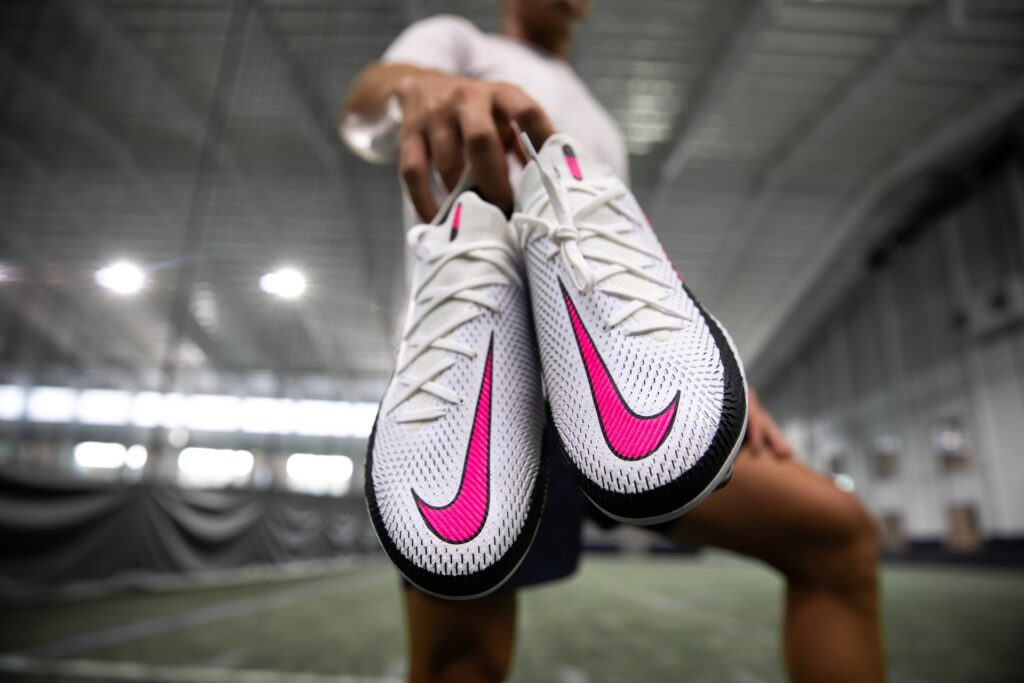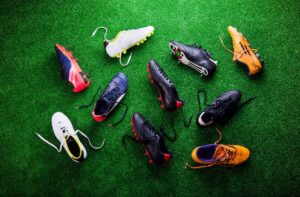Table of Contents
- How should soccer cleats fit?
- Should soccer cleats be tight?
- Do all brands of soccer cleats fit the same?
- How do you know when you need new soccer cleats?
- Recap: How should soccer cleats fit?
Footwear is undoubtedly one of the most important items for any soccer player – but how should soccer cleats fit?
The reality is that you need to select a pair of cleats that fit well and are comfortable, as these are the two most important things to consider before playing a match.
So, read on to find out what you need to know about how soccer cleats should fit to ensure that you don’t get blisters when playing the beautiful game this season.
How should soccer cleats fit?
Soccer cleats should fit like regular shoes. In other words, they should be snug, comfortable, and not too tight or too loose.
Some professional soccer players opt to size down their soccer cleats as they want a more sensitive touch when controlling the ball, but this isn’t necessary for amateur players and can cause more problems than it’s worth.
Therefore, before buying a pair of soccer cleats – particularly online – it’s a really good idea to visit a store to try a pair of cleats on, to ensure that they fit well on your feet.
Buying a pair of cleats that are too big or small will likely cause blisters, which is the last thing you need when you’re playing soccer.
Should soccer cleats be tight?
Most soccer players like their cleats to be snug, meaning that they fit well with very little movement at the heel or around the toes. Too much movement results in blisters, and it also makes it difficult to keep your balance while running.
Many soccer cleats loosen slightly once you start wearing them, particularly those made of leather and other synthetic materials, meaning you don’t need to buy a size up if your cleats feel ever so slightly tight when trying them on.
You can tell that a pair of soccer cleats fit you by following these tips:
• There should be no movement in the heel when you walk or run with the cleats on.
• You should have roughly the width of your thumb between the big toe and the edge of the boot.
• You shouldn’t be able to place your finger between your heel and the back of the shoe.
• The top of the cleats shouldn’t press hard down onto your feet, and there should be enough room for air to circulate.
Ultimately, soccer cleats shouldn’t be too tight that they suffocate your feet, as this will cause you discomfort while you’re playing. That being said, they should fit snugly to your feet, and there should be limited movement when you wear them on the field.
Do all brands of soccer cleats fit the same?

As is the case with all footwear, some people are suited to different brands over others, and it’s all down to personal preference. For instance, you could try on a pair of size 10 Nike soccer cleats, and they would feel different to a pair of size 10 Adidas cleats.
Therefore, if you order a pair of cleats from a brand for the very first time, it’s important to try a pair of cleats on in a store before committing to a purchase.
Although they will be roughly the same size, they won’t necessarily be a precise fit. You should always read a brand’s sizing guide before buying cleats as this will give you a good idea of what to expect when trying them on.
How do you know when you need new soccer cleats?
If you’re reading this article, the chances are that you’re thinking about buying a new pair of soccer cleats. However, if you’re on the fence about buying new cleats and you would like to keep playing in your current cleats, it’s helpful to think about how to know when you should really buy a new pair.
Some signs that it could be time to purchase a new pair of soccer cleats include the following:
• Worn-down or damaged studs, particularly those on the outsole.
• Holes or scuffed patches anywhere on the cleat.
• Delamination – where the surfaces on the outsole of the boot begin to separate.
• Rips or tears in the synthetic fabric or leather.
If you buy a good quality pair of soccer cleats, the chances are that they will last for a lot longer than those that are available for $50 or less. As the old saying goes – you get what you pay for – and it certainly pays to invest in a quality pair of cleats.
Recap: How should soccer cleats fit?
The bottom line is that soccer cleats should fit like any other shoe – they should be comfortable and snug. While many cleats loosen up a little bit after a few games, you don’t really need to bear this in mind when purchasing cleats, and you don’t need to size down as a result.
But given the fact that most brands fit slightly differently, we recommend checking out each brand’s sizing chart before buying cleats, and it makes sense to visit a sports store to try your cleats on before ordering them, to prevent you from being stuck with a pair of cleats that don’t fit you very well.
If you’re going to buy a new pair of cleats, make sure you read our guide to breaking in soccer cleats to ensure that you don’t hurt your feet this soccer season.

